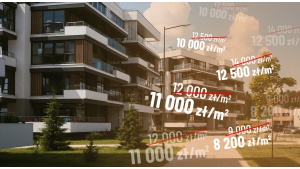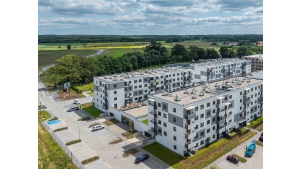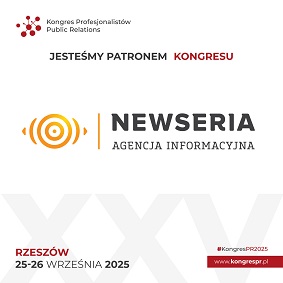In what direction is the Polish office market going
Prestige PR
Włodarzewska 81C lok 81
02-393 Warszawa
i.wisniewska|prestigepr.pl| |i.wisniewska|prestigepr.pl
508 927 958
www.prestigepr.pl
Mateusz Strzelecki_Partner and Head of Tenant Representation at Walter Herz
Have companies already adapted their space to the new work system? Do they prefer to renegotiate contracts or move to new locations?
Companies in Poland would like employees to return to their offices, but they must look for optimal solutions that would also meet teams expectations. In some companies, all employees work from the office, but they constitute only a few, maybe a dozen or so percent of organization. The system of 2/3 or 3/2 days of work a week from the office is becoming a standard on the market, and in some cases people work from the office much less frequently. Many employees who were employed during the pandemic also work from cities where companies are not headquartered.
The trend of optimizing space is visible. Tenants focus on a new, attractive space that supports work and creative thinking. In this way, they try to bind employees with the organization and integrate teams. The results of the research we have conducted show that most companies are satisfied with their offices in terms of location, but are working on changing their functionality, which means that we have increasingly more contract renegotiations.
The amount of vacant space in high-class facilities in the city centers is very limited and the demand is often high, even if they come with a contract for at least 7 years and usually an additional payment for fit-out or consumption of a significant part of the rent free periods.
How are the negotiations regarding the participation of building owners in the fit-out costs going?
In this case, a lot has changed in the last year and a half. Participants of the Warsaw market are aware that the preparation of a modern and functional turnkey office in a new property is a cost that Landlords are no longer able to bear in full. Despite 7-year contracts, the offered budgets are not sufficient for a complete fit-out. Tenants often convert additional incentives or share labor costs. The role of technical consulting, which is the main element of optimization of the fit-out costs, is all the more important now.
On the regional markets, the situation is better. In many cases involving key clients with 5-year contracts, it is possible to deliver turnkey space. However, it is related to the specification of space itself and its type. Warsaw which is home the largest organizations is a trendsetter (in the regions there are more SSC and BPO). There’s more extensive works in the field of design and ESG there, which generates higher costs.
How do tenants cope with the increase in office maintenance fees?
The main challenges of the office market are the high costs of fit-out and the amount of service charges. A natural step for companies is to verify operating costs. Most contracts impose a Triple Net structure. Tenants make advance payments towards the actual costs incurred by the Landlord, which is reasonable. In the case of a well-negotiated agreement, Tenants have a mechanism to verify the aforementioned costs, which are presented by Landlords, and to submit comments that should be taken into account. Unfortunately, there are Landlords on the market who include items in the structure of service charges that should not be there or distribute the costs in a non-transparent and unfavorable way for Tenants. One should also be careful about the costs related to the percentage of vacant space in the building that Landlords try to pass on to Tenants.
Electricity prices, which affect the amount of maintenance charges and are additionally a counter charge, are an increasing burden for Tenants. Many Landlords boast of securing favorable rates and investments that reduce these costs, such as LED lighting (standard in new facilities, and widespread modernization in older ones), motion sensors, solar panels or heat pumps, confirmed by LEED and BREEAM certificates. The solutions used in office buildings are part of the competition for customers.
Companies, on the other hand, are looking for the latest, more cost-friendly properties, implemented in accordance with ESG standards. Mainly Tenants from large foreign corporations ask about ESG solutions or WELL certificates. Polish companies set more and more ambitious goals in this regard, but they also have the cost element in mind. They are looking for solutions closest to ‘the sweet spot’. The situation can be compared to electric cars, the ideas are right, but the infrastructure and costs must keep up with the trend and regulations.
What is the supply situation in Warsaw? Is there a shortage of free offices in the city center on the Warsaw market?
Indeed, there is a shortage of large spaces in the central districts of Śródmieście and Wola, which are the most attractive areas for Tenants. In these locations, asking rents have also increased and ‘the market belongs to the Landlords’ there.
The stagnation in the field of investment is worrying. Few new projects enter the market, but there is a slight optimism and conviction that the situation will start to improve in the upcoming months. In the area of the city center, several investments are underway, but they will appear on the market in 2 to 4 years.
The situation is quite different in Mokotów, which used to be the largest office district in the country in Służewiec, where the vacancy rate exceeds 20 per cent. Tenants have a wide range of space options to choose from and negotiate lease terms.
Is it time to modernize older buildings in Warsaw? Are owners willing to invest?
The answer is not clear cut. There are owners who invest and those who wish to sell real estate, because the costs incurred with an unsatisfactory level of income expose the weakness of the investment. It can be assumed that, apart from conversions, we will also be able to observe more and more demolitions of older buildings, because often the land on which they are located provides disproportionately greater opportunities for their development in terms of new investments. We already have examples of such projects as the conversion of Atrium into Upper One, or the construction of T22 mixed-use complex on the Centrum Jupiter plot.
What is the situation in the regions? Is there interest in offices? Will there be more vacancies? On which markets?
The situation varies from location to location. There is a lack of high-quality space in city centers, which is most noticeable in Warsaw and Cracow, where at the same time the average vacancy rate is favorable for Tenants. The high vacancy rate affects Wroclaw and the Tri-City, which are definitely Tenant markets. There is a lack of new investments, but it seems that in the perspective of 2-3 years, the situation should normalize and a healthy balance of new supply and demand should be achieved. In this situation, renegotiations gain an advantage.
Are companies from beyond the eastern border still looking for space?
The companies that entered Poland before the outbreak of the conflict were mainly IT companies that are developing very dynamically. Since March 2022, many organizations from the East have entered the Polish market and are rapidly developing here. Entities that have relocated their businesses are now switching from flex solutions to regular rental. Some companies plan on returning to their country, some have already gone home, but they are in the minority.

Deweloperzy ukrywają ceny mieszkań. Z troski o klientów czy swoje portfele?

Więcej przestrzeni, mniej hałasu – dlaczego Polacy coraz częściej wybierają przedmieścia?

Jak czytać rzuty mieszkań i uniknąć przykrych niespodzianek? AI ułatwia wybór
Więcej ważnych informacji
 Jedynka Newserii
Jedynka Newserii

 Jedynka Newserii
Jedynka Newserii

Handel

Polskie MŚP otrzymają większe wsparcie w ekspansji międzynarodowej. To cel nowej inicjatywy sześciu instytucji
Firmy z sektora małych i średnich przedsiębiorstw otrzymają kompleksowe wsparcie na potrzeby zwiększania konkurencyjności na arenie międzynarodowej. Taki jest cel wspólnej inicjatywy instytucji zrzeszonych w Grupie PFR pod szyldem Team Poland. Obejmuje ona zarówno wsparcie kapitałowe, w postaci gwarancji, pożyczek czy ubezpieczenia, jak i doradztwo oraz wsparcie promocyjne i informacyjne, dzięki czemu mikro-, małym i średnim firmom łatwiej będzie podjąć decyzję o ekspansji zagranicznej. Pierwszy projekt dotyczy wsparcia dla firm zainteresowanych uczestnictwem w odbudowie Ukrainy.
Bankowość
RPP zgodna co do potrzeby obniżania stóp procentowych. Trwają dyskusje dotyczące tempa tych decyzji

W lipcu Rada Polityki Pieniężnej po raz drugi w tym roku obniżyła stopy procentowe, określając swój ruch mianem dostosowania. W kolejnych miesiącach można oczekiwać kolejnych obniżek, ale ich tempo i termin będą zależeć od efektów dotychczasowych decyzji i wzrostu płac. Docelowo główna stopa procentowa ma wynosić 3,5 proc. Te okoliczności sprzyjają kredytobiorcom.
Handel
Umowa z krajami Mercosur coraz bliżej. W. Buda: Polska nie wykorzystała swojej prezydencji do jej zablokowania

– Polska podczas prezydencji w Radzie UE nie wykorzystała szansy na obronę swoich interesów w sprawie umowy z krajami Mercosur – ocenia europoseł PiS Waldemar Buda. W jego ocenie polski rząd, mimo sprzeciwu wobec zapisów umowy, nie zbudował w UE sojuszy niezbędnych do jej odrzucenia. Porozumienie o wolnym handlu spotyka się przede wszystkim z protestami europejskich rolników, którzy obawiają się zalania wspólnego rynku tańszą żywnością z krajów Ameryki Południowej. Według europosła wszystko może się rozegrać w najbliższych tygodniach.
Partner serwisu
Szkolenia

Akademia Newserii
Akademia Newserii to projekt, w ramach którego najlepsi polscy dziennikarze biznesowi, giełdowi oraz lifestylowi, a także szkoleniowcy z wieloletnim doświadczeniem dzielą się swoją wiedzą nt. pracy z mediami.




![Część środków z Planu Społeczno-Klimatycznego trafi na walkę z ubóstwem transportowym. Organizacje branżowe apelują o zmianę priorytetowych projektów [DEPESZA]](https://www.newseria.pl/files/1097841585/rower3,w_85,_small.jpg)




.gif)

 |
| |
| |
|